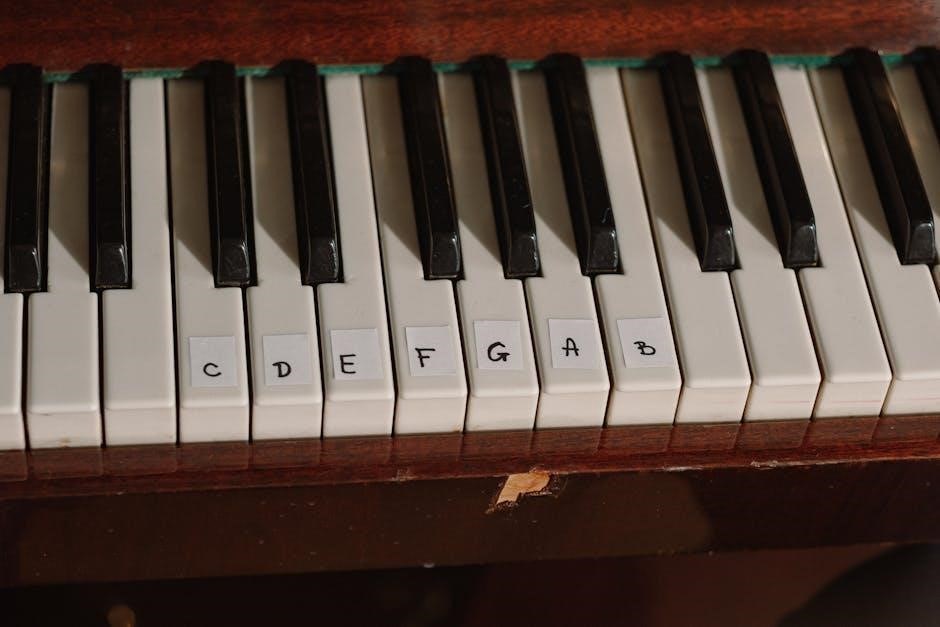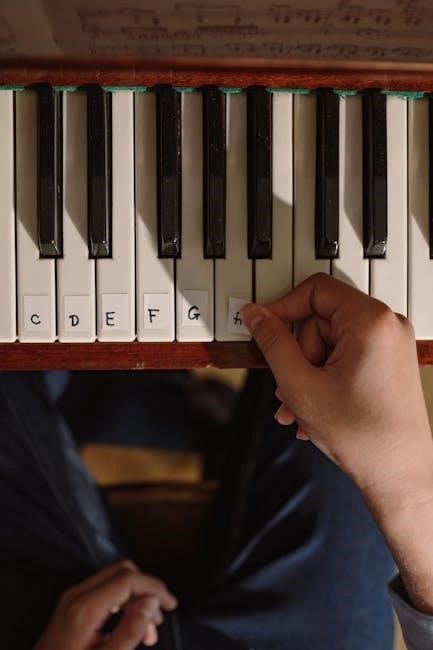Minor piano scales are essential for musicians, offering a rich, emotional sound. This guide covers natural, harmonic, and melodic minor scales, providing formulas, key signatures, and practice resources, including downloadable PDFs for all 12 keys.
1.1 Definition and Overview of Minor Scales
Minor scales are a fundamental element in music, characterized by a distinct sequence of whole and half steps. They are often associated with a somber or melancholic sound compared to major scales. A minor scale is defined by its intervals: whole, half, whole, whole, half, whole, and half steps. There are three types—natural, harmonic, and melodic—each with unique structures and uses. Minor scales are essential for composition, improvisation, and understanding music theory. They are widely used across various genres and can be practiced using downloadable PDF resources, which provide fingering charts and key signatures for all 12 minor scales.
1.2 Importance of Minor Scales in Music
Minor scales play a vital role in music, offering a diverse emotional palette for composers and performers. They are integral to various genres, from classical to jazz and pop, providing depth and complexity. Understanding minor scales enhances musical expression, allowing for richer harmonies and melodies. Musicians use minor scales to evoke specific moods, making them indispensable in both composition and improvisation. Additionally, mastering minor scales improves technical proficiency on instruments like the piano. Their application spans from creating somber tones to crafting intricate musical pieces, highlighting their significance in the broader context of music theory and practice, as detailed in available PDF guides.
1.3 Types of Minor Scales: Natural, Harmonic, and Melodic
Minor scales are categorized into three distinct types: natural, harmonic, and melodic. The natural minor scale follows a specific whole-halftime formula, providing a somber, introspective sound. The harmonic minor scale raises the 7th scale degree, creating a dramatic, tense quality often used in composition. The melodic minor scale differs in its ascending and descending forms, with the 6th and 7th degrees raised when ascending, offering a rich, expressive sound. Each type serves unique musical purposes, and understanding their structures is crucial for musicians. These scales are detailed in PDF resources, making them accessible for study and practice across all 12 keys.

Natural Minor Scales
Natural minor scales are the foundation of minor tonality, characterized by their distinct whole-halftime formula. They evoke a somber, introspective sound and are widely used in music composition and improvisation.
2.1 Structure and Formula of Natural Minor Scales
The natural minor scale follows a specific whole-half step pattern: W-H-W-W-H-W-W. This structure produces a distinctive, melancholic sound. Each scale consists of seven notes, with the intervals between them adhering to this formula. For example, the A natural minor scale is A-B-C-D-E-F-G-A. This pattern remains consistent across all natural minor scales, ensuring a uniformity in their construction. Understanding this formula is crucial for musicians, as it allows for the creation of scales in any key, facilitating composition and improvisation. PDF resources are available for all 12 natural minor scales, aiding in practice and mastery.
2.2 How to Construct Natural Minor Scales
To construct a natural minor scale, start with a root note and follow the whole-half step pattern: W-H-W-W-H-W-W. For example, beginning on A, the intervals would be: A (W) to B, B (H) to C, C (W) to D, D (W) to E, E (H) to F, F (W) to G, and G (W) back to A. This sequence ensures the scale spans an octave and maintains the natural minor sound. By applying this formula to any root note, musicians can build all 12 natural minor scales. PDF guides are available for reference, providing fingering charts and key signatures for practice.
2.3 Key Signatures of Natural Minor Scales
Natural minor scales each have unique key signatures determined by their relative major scale. For instance, the key of A natural minor has no sharps or flats, while E natural minor has one sharp (F♯). The number of sharps or flats increases or decreases based on the scale’s position in the circle of fifths. PDF resources provide clear visuals of these key signatures, aiding pianists in recognizing patterns and intervals. Understanding these signatures is crucial for accurate scale performance and composition, making them an essential tool for musicians learning natural minor scales.
2.4 Examples of Natural Minor Scales in Music
Natural minor scales are frequently used in various musical compositions to evoke emotional depth. For instance, Beethoven’s “Für Elise” and Chopin’s nocturnes often incorporate natural minor scales to create somber, reflective moods. These scales are also common in folk music, such as traditional Celtic and Middle Eastern melodies, adding a sense of melancholy; Many modern composers and pianists use natural minor scales to convey introspection and drama. PDF guides and sheet music highlight these examples, allowing pianists to study and play iconic pieces that showcase the beauty of natural minor scales in different musical contexts.

Harmonic Minor Scales
Harmonic minor scales are a type of minor scale with a raised 7th scale degree, creating a distinct sound. They’re often used in classical and jazz music to add tension and emotional depth. PDF resources provide charts and exercises for mastering these scales in all 12 keys, helping pianists improve their technique and musical expression. These scales are essential for understanding harmonic structure and enhancing compositional skills.
3.1 Structure and Formula of Harmonic Minor Scales
The harmonic minor scale is structured with a specific interval pattern: whole, half, whole, whole, half, whole, half. This sequence creates a distinctive sound. The formula is:
1, 2, b3, 4, 5, b6, 7, 8.
The seventh note is raised by a half-step compared to the natural minor scale, forming a leading tone. This alteration facilitates harmonic functions, particularly in creating dominant seventh chords. PDF resources provide clear diagrams and exercises for each key, aiding pianists in mastering this complex yet expressive scale. Understanding this structure is crucial for both composition and improvisation in various musical genres.
3.2 How to Construct Harmonic Minor Scales
To construct a harmonic minor scale, start with the natural minor scale and raise the seventh note by a half-step. For example, in A harmonic minor, the seventh note (G) becomes G#. This creates a leading tone, enhancing harmonic functionality. Begin with the tonic note, then follow the interval pattern: whole, half, whole, whole, half, whole, half. PDF guides provide step-by-step instructions and keyboard visuals for all 12 keys, making the process accessible. This method ensures accuracy and helps pianists build a strong foundation for playing harmonic minor scales confidently across the piano keyboard. Regular practice reinforces this construction technique.
3.3 Key Signatures of Harmonic Minor Scales
The key signatures of harmonic minor scales are derived from their natural minor counterparts but include an additional sharp for the seventh scale degree. For example, A harmonic minor has the same key signature as A natural minor (no sharps or flats) but raises the seventh note (G) to G#. This pattern applies to all harmonic minor scales, with each key signature mirroring its natural minor relative but adding one sharp. PDF resources often list these key signatures, making it easy to identify and play harmonic minor scales across all 12 keys. This consistent pattern aids in quick recognition and practice.
3.4 Examples of Harmonic Minor Scales in Music
Harmonic minor scales are frequently used in classical and jazz music to create dramatic, exotic sounds. Beethoven’s “Moonlight Sonata” features harmonic minor motifs, while jazz standards like “Maiden Voyage” by Herbie Hancock utilize harmonic minor scales for their distinctive flavor. PDF guides highlight these examples, showing how composers and improvisers employ the scale’s unique intervals. By studying these examples, musicians can gain insight into the practical applications of harmonic minor scales, enhancing their composition and improvisation skills. These resources provide clear notations and fingering charts, making it easier to learn and apply harmonic minor scales in various musical contexts.

Melodic Minor Scales
Melodic minor scales are used in jazz and classical music, offering a bright, uplifting sound. They feature a raised 6th and 7th degree, creating unique harmonic possibilities for composition and improvisation.
4.1 Structure and Formula of Melodic Minor Scales
The melodic minor scale consists of the intervals: whole, half, whole, whole, whole, whole, half. Ascending, it raises the 6th and 7th scale degrees, creating a distinct sound used in improvisation and composition. When descending, it returns to the natural minor form. This structure allows for rich harmonic possibilities and is often employed in jazz and classical music to add tension and emotional depth. Understanding the melodic minor scale’s formula is crucial for musicians aiming to expand their harmonic and melodic vocabulary.
4.2 How to Construct Melodic Minor Scales
To construct a melodic minor scale, start with the natural minor scale and raise the 6th and 7th scale degrees by one half-step when ascending. For example, in A melodic minor, the 6th note (F) becomes F# and the 7th note (G) becomes G#. When descending, the scale reverts to the natural minor form. This unique alteration creates a distinctive sound often used in jazz and classical music. The process involves identifying the tonic note, building the natural minor scale, and then adjusting the 6th and 7th degrees for the ascending melodic minor form.
4.3 Key Signatures of Melodic Minor Scales
Melodic minor scales have unique key signatures that reflect their raised 6th and 7th scale degrees when ascending. For example, the A melodic minor scale has the same key signature as D major (two sharps: F# and C#) but includes additional accidentals for the raised notes. Each melodic minor scale’s key signature is determined by its tonic note and the alterations required for the ascending form. These key signatures differ from natural and harmonic minors, as they incorporate both the natural minor framework and the melodic adjustments. This structure allows for a distinctive sound, widely used in jazz and classical compositions.
4.4 Examples of Melodic Minor Scales in Music
Melodic minor scales are frequently used in various musical genres to evoke emotional depth. Jazz standards often employ melodic minors for improvisation, while classical pieces like Beethoven’s Moonlight Sonata feature their haunting beauty. For instance, the A melodic minor scale is prominent in improvisational solos, adding a rich, exotic flavor. Composers such as Chopin and Debussy have also utilized melodic minors to create intricate harmonies. These scales are versatile, appearing in film scores and contemporary music as well. Their unique interval structure makes them a popular choice for creating tension and resolution, enhancing the expressive quality of musical compositions across different styles and eras.

Key Signatures and Relative Majors
Understanding key signatures and relative majors is crucial for mastering minor scales. Each minor scale shares its key signature with its relative major, simplifying learning and application.

5.1 Understanding Key Signatures for Minor Scales
Key signatures for minor scales are essential for identifying the notes and accidentals used in a piece. They appear at the beginning of sheet music and apply to all notes of that name. The Circle of Fifths helps determine the order of sharps and flats in minor keys. Natural minor scales share their key signature with their relative major scale, simplifying the learning process. For example, A natural minor and C major share the same key signature. Understanding these relationships is crucial for composing, improvising, and interpreting music. Printable PDF resources are available to practice and memorize key signatures for all minor scales.
5.2 Finding Relative Major Scales
Finding the relative major scale of a minor scale is straightforward. The relative major shares the same key signature and starts on the third note of the minor scale. For example, A minor’s relative major is C major. This relationship simplifies learning, as both scales use the same accidentals and differ only in tonal center. PDF guides and charts are available to help musicians quickly identify and practice relative major scales, enhancing their understanding of key relationships and musical structure.
5.3 Circle of Fifths and Minor Scales
The Circle of Fifths is a powerful tool for understanding key relationships. Minor scales are positioned on the circle, with each key separated by a perfect fifth. Moving clockwise adds sharps, while counterclockwise adds flats. For example, A natural minor is positioned next to C major, its relative major. This visual representation helps musicians identify relative majors and minors, key signatures, and scale degrees. PDF charts often include the Circle of Fifths to illustrate these relationships, making it easier to learn and reference minor scales in various musical contexts. This circular arrangement simplifies understanding harmonic structure and scale connections.

Fingering for Minor Scales on Piano
Mastering fingering for minor scales is essential for smooth piano performance. PDF resources offer detailed fingering charts for natural, harmonic, and melodic minor scales, covering both hands. Consistent practice ensures proper technique and builds muscle memory.
6.1 Fingering Charts for Natural Minor Scales
Natural minor scales have specific fingering patterns that ensure smooth and efficient playing. For example, the A natural minor scale uses the fingering (LH): 5, 4, 3, 2, 1, 3, 2, 1, and (RH): 1, 2, 3, 1, 2, 3, 4, 5. These charts are designed to help pianists maintain proper hand position and dexterity. PDF resources provide detailed fingering diagrams for all 12 natural minor scales, making it easier to practice and master each scale systematically. Consistent use of these fingerings helps build muscle memory and improves overall technique for flawless performances.
6.2 Fingering Charts for Harmonic Minor Scales
Fingering charts for harmonic minor scales are tailored to accommodate the raised seventh scale degree, which distinguishes them from natural minor scales. For instance, the D harmonic minor scale uses specific fingerings to navigate the interval between the sixth and seventh notes smoothly. These charts are designed to maintain hand balance and dexterity, ensuring even tone production. PDF resources provide clear diagrams for all 12 harmonic minor scales, offering a visual guide for pianists. By practicing with these fingering charts, musicians can master the unique structure of harmonic minor scales and enhance their technical and expressive abilities effectively.
6.3 Fingering Charts for Melodic Minor Scales
Fingering charts for melodic minor scales are designed to address the unique challenges posed by their ascending and descending forms. The raised sixth and seventh scale degrees in the ascending melodic minor require precise finger placement to maintain fluency. PDF resources offer detailed fingering guides for all 12 keys, ensuring smooth transitions between notes. These charts help pianists develop consistent technique and control, especially when navigating the scale’s distinctive intervals. By practicing with these charts, musicians can achieve a polished performance of melodic minor scales, enhancing both technical accuracy and expressive interpretation.
6.4 Tips for Smooth Scale Playing
Mastering smooth scale playing requires consistent practice and attention to detail. Start with slow tempos, focusing on even tone and rhythm. Use metronomes to gradually increase speed. Practice scales in both hands separately before combining them. Pay attention to finger independence and weight transfer. Break scales into smaller sections and repeat problem areas. Incorporate dynamics and articulations for musicality. Regularly review fingering charts from PDF resources to ensure accuracy. Record yourself to identify areas for improvement. Maintain relaxed hand positions to prevent fatigue and injury. Consistent, mindful practice will lead to fluid and polished scale performances across all minor scales.

Practical Applications of Minor Scales
Minor scales are versatile tools for composition, improvisation, and exploring various music genres, enhancing emotional depth and creativity in piano performances across different musical styles and contexts.
7.1 Using Minor Scales in Composition
Minor scales are a powerful tool for composers, adding depth and emotion to musical pieces. By incorporating natural, harmonic, and melodic minor scales, composers can create intricate harmonies and motifs that evoke specific moods. These scales are particularly effective in crafting melancholic or dramatic themes, often used in classical, jazz, and contemporary music. Understanding the structure of each minor scale type allows composers to experiment with chord progressions and melodies, enhancing the overall impact of their work. Utilizing minor scales can also provide a rich foundation for improvisation and thematic development, making them indispensable in various compositional contexts.
7.2 Improvisation with Minor Scales
Minor scales are a cornerstone of improvisation, offering a wealth of emotional expression. Natural minor scales provide a somber, reflective foundation, while harmonic minor scales introduce tension with their raised 7th degree, ideal for dramatic solos. Melodic minor scales, with their ascending brightness and descending melancholy, add versatility to improvisational phrases. By mastering these scales, musicians can craft solos that evoke deep emotion, whether in jazz, blues, or classical contexts. Practicing minor scales in all keys enhances fluidity and spontaneity, allowing improvisers to explore complex harmonic landscapes with confidence and creativity.
7.3 Minor Scales in Different Music Genres
Minor scales are versatile and appear across various music genres. In classical music, composers like Beethoven and Chopin frequently used natural minor scales to evoke solemnity. Jazz musicians often employ harmonic minor scales for their distinctive, exotic sound. Melodic minor scales shine in improvisational settings, adding a bright, ascending quality. Rock and pop music utilize minor scales to create introspective or intense moods, while world music genres incorporate minor scales to reflect cultural and emotional depth. Understanding how minor scales function in different genres enhances a musician’s ability to compose and perform authentically, bridging cultural and stylistic boundaries through their universal emotional resonance.

Downloading Minor Scale PDF Resources
Minor scale PDFs are readily available online, offering convenient practice tools. Websites like PianoLessons.com provide comprehensive resources, including all 12 keys, natural, harmonic, and melodic scales, along with fingering charts for both hands, making them invaluable for pianists of all skill levels.
8.1 Where to Find Minor Scale PDFs
Minor scale PDFs are widely available online, with reputable sources like PianoLessons.com and Musicnotes offering free and premium resources. These PDFs typically include all 12 natural, harmonic, and melodic minor scales, often with fingering charts for both hands. Many websites organize scales by the circle of fifths, making it easy to compare and practice. Additionally, platforms like PDFMiner and ScalesAndArpeggios.com provide downloadable sheets tailored for piano students. Some sites also offer interactive tools and video tutorials to complement the PDF materials, ensuring comprehensive learning and practice opportunities for musicians of all levels.
8.2 How to Use Minor Scale PDFs for Practice
To effectively use minor scale PDFs for practice, start by downloading resources from reputable sites like PianoLessons.com or Musicnotes. Print or display the PDFs clearly, ensuring they are organized by key or type for easy access. Begin by playing each scale slowly, focusing on correct fingering and dynamics as indicated. Gradually increase your speed as you gain comfort, using a metronome to improve timing. Incorporate scales into your daily routine, dedicating 15-20 minutes to practice, and consider integrating them into your repertoire for applied learning. Explore genres like jazz or classical that utilize minor scales to enhance engagement. Supplement your practice with video tutorials or apps for feedback, and maintain a practice journal to track progress and stay motivated.
8.3 Benefits of Using PDF Resources
Using PDF resources for minor piano scales offers numerous advantages. They provide clear, organized charts for all 12 keys, making learning and practice efficient. PDFs are easily downloadable and accessible, allowing musicians to practice anywhere without internet. Many resources are free, making them cost-effective for students and hobbyists. They often include fingering guides, key signatures, and scale formulas, ensuring comprehensive understanding. PDFs can be printed for physical use or viewed digitally, catering to different learning preferences. Additionally, they serve as valuable references for composers and educators, offering structured content that aligns with musical theory. This accessibility and convenience make PDFs indispensable for mastering minor scales.

Common Mistakes When Learning Minor Scales
Common mistakes include misunderstanding scale formulas, incorrect fingering, and poor practice habits. These errors can hinder progress and technique development in mastering minor scales effectively.
9.1 Misunderstanding Scale Formulas
One common mistake is misunderstanding the scale formulas, particularly the differences between natural, harmonic, and melodic minor scales. Each type has a specific interval pattern, and confusing these can lead to incorrect note sequences. For instance, the natural minor scale follows the formula W-H-W-W-H-W-W, while the harmonic minor raises the seventh scale degree by a half step, and the melodic minor raises the sixth and seventh degrees when ascending. Students often mix these patterns, resulting in scales that don’t align with their intended type. Clear understanding and consistent practice are essential to avoid such errors and ensure accuracy.
9.2 Incorrect Fingering Techniques
Incorrect fingering techniques are a common obstacle when learning minor piano scales. Many students use inconsistent or inefficient fingerings, leading to poor dexterity and uneven tone. For example, using the same finger for consecutive notes or failing to alternate fingers properly can hinder smooth scale execution. It’s crucial to follow established fingering patterns, as they optimize hand position and balance. Incorrect fingering can also cause fatigue and tension, making practice less effective. Referencing fingering charts for natural, harmonic, and melodic minor scales can help develop proper habits. Consistent practice with correct fingerings ensures technical accuracy and expressive playing.
9.3 Poor Practice Habits
Poor practice habits can significantly hinder progress in mastering minor piano scales. Practicing without a metronome often leads to inconsistent tempo and rhythm. Additionally, neglecting to warm up before playing can result in stiffness and technical errors. Many students also make the mistake of rushing through scales without focusing on accuracy, leading to the development of bad habits. It’s essential to break scales into smaller sections, practice hands separately, and gradually increase speed. Using PDF resources with fingerings and exercises can guide structured practice. Consistent, focused practice with attention to detail ensures steady improvement and mastery of minor scales.
10.1 Summary of Minor Scales
Minor scales are foundational in music, offering emotional depth and complexity. They include natural, harmonic, and melodic forms, each with distinct structures and uses. Natural minor scales follow the W-H-W-W-H-W-W pattern, while harmonic and melodic scales introduce raised leading tones for specific musical effects. Understanding these scales enhances composition, improvisation, and performance across genres. Key signatures and relative majors are crucial for navigating minor scales, with resources like PDF charts providing practical support; Mastery of minor scales expands musical expression, making them an essential tool for pianists and composers.
10.2 Recommended Reading and Video Tutorials
For deeper understanding, explore resources like “The Musician’s Guide to Theory and Analysis” and “Harmony and Theory” by Mark Levine. Video tutorials on YouTube channels such as Piano Lessons Online and Music Theory Fundamentals provide visual aids. Websites like PianoLessons.com offer comprehensive lessons. Additionally, platforms like Udemy and Coursera feature courses on music theory and piano scales. These resources complement PDF guides, offering practical exercises and detailed explanations to enhance learning. They cater to all skill levels, ensuring a well-rounded approach to mastering minor scales.
10.3 Encouragement for Continued Practice
Mastering minor piano scales is a rewarding journey that enhances musical expression and technical skill. Consistent practice, even for short durations, leads to progress. Celebrate small achievements to stay motivated, as each scale learned brings you closer to musical fluency. Embrace challenges as opportunities to grow and explore the emotional depth of minor scales. Utilize the provided PDF resources and video tutorials to guide your practice. Remember, the journey to mastery is lifelong, and every note played is a step forward. Stay dedicated, and the beauty of minor scales will resonate through your music.